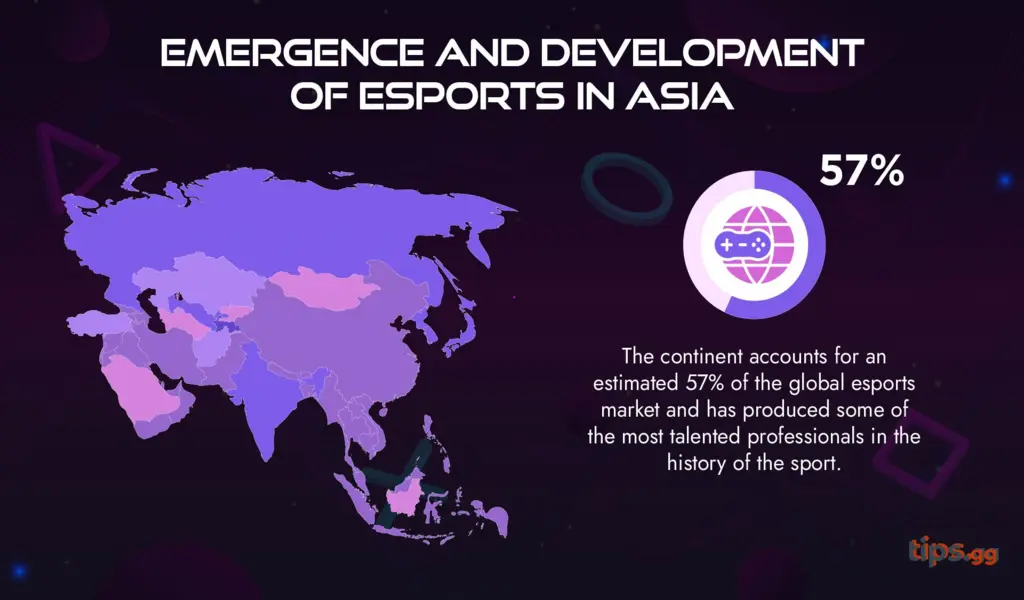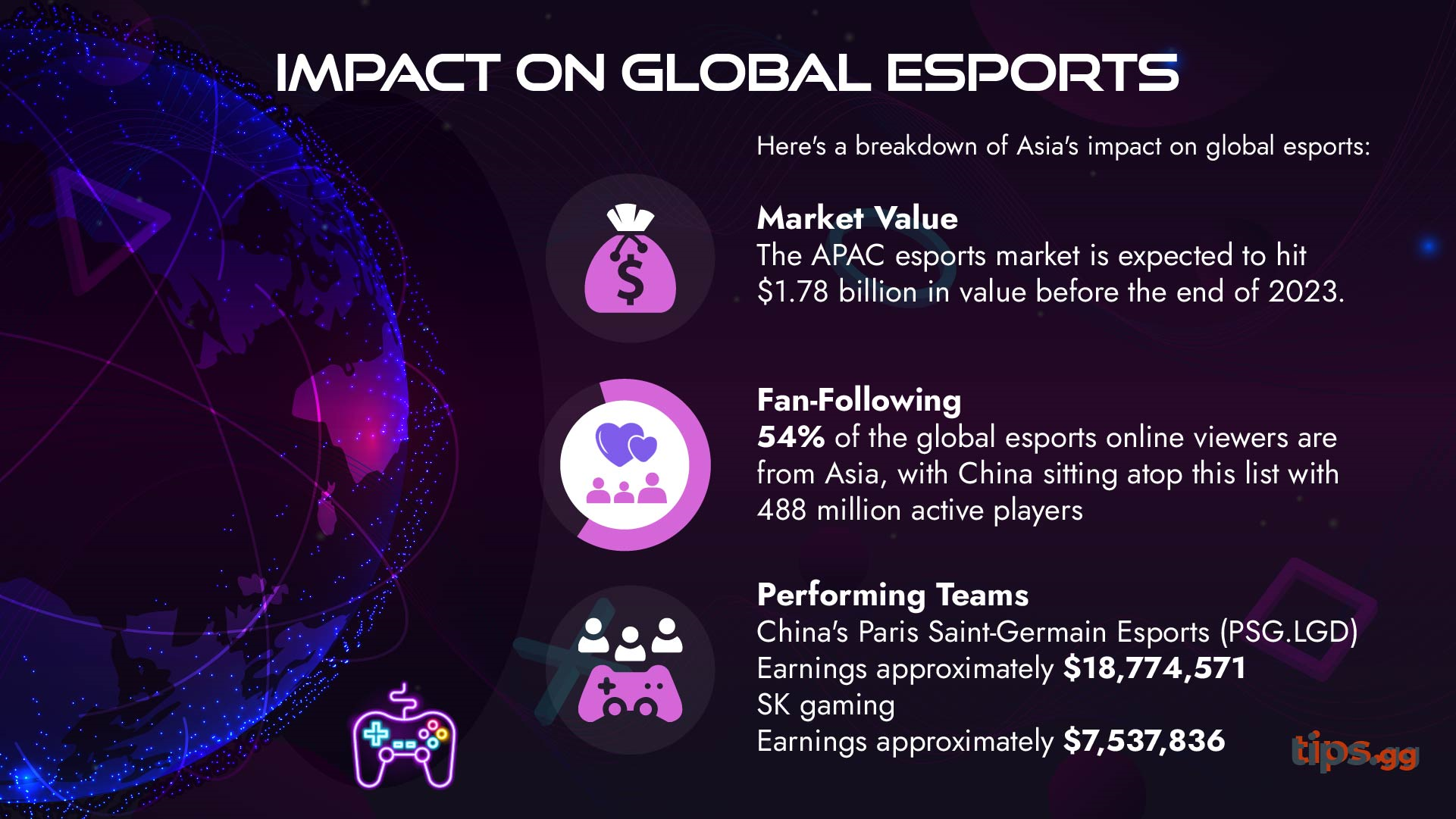Gaming
Emergence and Development of Esports in Asia

Discover the emergence of esports tournaments in Asia, from its early beginnings, to its rapid growth and impact on the global esports market.
Asia is the world’s largest region for esports. The continent accounts for an estimated 57% of the global esports market and has produced some of the most talented professionals in the history of the sport.
Esports in the Asian-Pacific region (APAC) has experienced consistent growth over the years, and the future prospects are encouraging. This article explores the origin of esports and how it has grown into the multi-million dollar industry it is today.
Discover the early beginnings of the sports discipline and some fascinating esports stats. All information and analysis was provided by Tips.gg, a reliable esports resource.
Brief History
Esports in Asia originated as far back as the late 1990s and early 2000s when StarCraft broke into the South Korean market. The competitive game has been credited for laying the foundation for what esports has become in Asia.
StarCraft quickly became a fan-favorite in the country after its launch in the late 1990s. At the time, competitive gaming enthusiasts organized talent competitions at local PC cafes. This pattern soon spread throughout the country, and in a short span, interest in competitive gaming increased dramatically.
While many locals were already falling in love with esports, its turning point in South Korea didn’t come until the early 2000s when local TV stations throughout the country began to broadcast professional multi-player esports matches.
Heightened coverage from different media outlets quickly helped esports to gain legitimacy in South Korea, and in a short matter of time, teams and organizational bodies, such as the Korean eSports Association (KeSPA) were established.
The enormous success of StarCraft in the mid-2000s inspired neighboring Asian countries like China and Japan to embrace esports. These countries also experienced a rise in esports events and growing interest in the sport.
Technological advancements and China’s growing population influenced the growth of esports in the country. The accessibility of personal computers and internet cafes were the perfect recipe to establish a gaming culture. Chinese players quickly adopted the new trend, and game developers began to churn out titles to meet heavy demands.
As the popularity of esports spread across Asia, professional players emerged and tournaments began to receive official recognition and support from governments.
Asia Esport Powerhouses
China, South Korea, and Japan rank among the top 15 highest earning countries in the world.
Below are the biggest countries in Asia’s esports landscape
South Korea: Where Esports Found Its Home
You cannot tell the story of esports in Asia without mentioning South Korea. The nation not only introduced esports to this region, but has also remained one of the biggest esport markets in the world.
The South Korean government has continued to promote esports through funding and infrastructure. For example, the country is home to the world’s first sports venue constructed specifically for online gaming. The arena is located in Seoul’s Yongsan district and is scheduled to host upcoming esports events later in the year.
South Korea ranks second in global esports earnings, with a combined total of $131,049,688.79 won among 5,334 players. League of Legends remain the country’s most rewarding game, netting $34,046,189.95
With a rich history in competitive gaming, South Korea has produced some of the world’s most iconic esports players, like top world earners Lee, Sang Hyeok, Cho, Sung Choo, and Lee, Byung Ryul. The country also has thriving professional esports leagues, with iconic teams that have excelled in popular titles like Leagues of Legend, StarCraft II, and Overwatch.
China: A Colossus in Esports
China boasts a rich roster of talents that have made their respective marks in games like Dota 2, Arena of Valor, and League of Legends. Esports teams in China continually excel overwhelmingly in international competitions, thanks to the esports infrastructure and strong fanbase.
Chinese players have made a staggering $250,757,038.27 from professional esports tournaments, the most of any country in the world. Top earners include Wang, Chunyu (Ame), Zhang, Yiping, and Zhang, Ruida. Ame is the 17th most paid player in the world with combined earnings of $3,912,904.27.
Japan: The Fast Rising Sun of Esports
Japan may not have tapped into the Asian esports ecosystem as early as its neighbors, but it has experienced rapid growth in a short while. The country ranks 14th in the world, thanks to 2,933 players combining for $30,545,105.40 in total prize money.
Shuma Kakinuma leads the way on Japan’s top earners list with an overall earning of $1,228,551.54. Ryutaro Okumoto is the only other millionaire earner on this list, earning $1,003,000 throughout his professional career.
Japanese players have a unique taste for fighting games compared to some of its Asian counterparts. Currently, the most popular titles in Japan are PUBG Mobile, Shadowverse, and Fortnite.
Taiwan: The Island of Gaming Prowess
Taiwan ranks as the 18th highest paid esport market in the world, with 1,524 Taiwanese gamers combining for $18,725,778.14 across 1,997 tournaments.
Esports competitions in Taiwan attract massive crowds, and you’ll often see them cheering players on passionately during games. Taiwan is particularly renowned for its success in games like League of Legend and Arena of Valor.
Xu “Jimmy” Yinjun holds the record for the highest earning Taiwanese esports player ($1,243,417.20). He is closely followed by Lin “King” Yien ($1,028,844.29) and Sasamumu ($1,000,000.00).
Rapid Growth and Investment
The APAC esports ecosystem is growing rapidly before our eyes. According to Juniper, about 50% of the world’s esports viewers will be from the Asia Pacific region, which is huge considering how big the sporting discipline already is.
We explore some of the factors that are contributing to the growth of esports in Asia.
Technological Adaptation
Technological advancement in Asia is growing at a fast pace and the region’s youth population, many of whom have adapted to modern digitization, has continued to grow.
The increasing adaptation to technology combined with the passion for gaming deeply rooted in Asian culture has played a significant role in increased interest in esports.
Dedicated Fanbase
Asian esports fans are renowned for their dedication to esports. Their unwavering enthusiasm and support for their favorite teams and players has helped to transform esports competitions into must-see events. As a result, esports arenas in Asia are usually packed with people and live streams attract massive viewers all across the world.
Sponsorships and Endorsements
Asia’s thriving esports community has attracted sponsorships and endorsements from several big name brands. For example, fast food chain brand KFC recently bought the naming rights to Thai pro team Talon Esports. Evos Esports, an Indonesian professional team also currently enjoys a sponsorship deal with Yamaha Motor.
Media Presence
Nowadays, esports matches are being televised on national TV and popular gaming platforms like Twitch have made it possible for Asia’s competitive gaming market to reach a wider global view.
Government Support
Governments across the continent have recognized esports as an industry that contributes to its socioeconomic prosperity. As a result, many government policies have been set in place to favor the growth of esports.
Some Asian countries also have esports facilities built by their respective governments. South Korea, for example, has many venues, like the 20,000-seater Sangam World Cup Stadium and the 40,000-capacity Incheon Munhak Stadium that host country-wide and global that have hosted esports teams in the past.
Regional Gaming Culture
Esports continues to grow in popularity in Asia thanks to its incorporation of cultural elements, like socialization, competition, and pop culture.
For instance, Asian societies have always considered gaming as an integral aspect of their social sphere. This communal aspect of gaming has influenced the growth of a sporting discipline that brings people together like esports.
Asians are also known for their love for competitive sports and games, like martial arts and table games. Since esports also encourages competition, it will continue to grow in this region.
Furthermore, many esports games today have drawn inspiration from anime, which is an integral aspect of modern Asian culture. As a result, Anime-based games like Mobile Legends: Bang Bang are some of the most successful esports games in South Asia.
Impact on Global Esports
APAC has the highest share of the global gaming market and the largest gaming communities in the world. It also continues to produce some of the most successful teams and players. Experts predict that the region’s thriving esport market will be a major driver for innovation and growth in the coming years.
Here’s a breakdown of Asia’s impact on global esports:
Market Value
The APAC esports market is expected to hit $1.78 billion in value before the end of 2023. China, South Korea, and Japan are expected to rank among the top countries to generate high revenue from esports.
Fan-Following
54% of the global esports online viewers are from Asia, with China sitting atop this list with 488 million active players, according to the China Game Industry Development Research Institute. It also boasts approximately 163 million viewers and 93 million esports enthusiasts, according to Newzoo.
Performing Teams
China’s Paris Saint-Germain Esports (PSG.LGD) is the most successful team in Asia, with total earnings of approximately $18,774,571.91 from 156 tournaments, and also ranks 8th in the world rankings of highest earning teams. SK gaming is Asia’s second highest earner, netting a combined prize reward of $7,537,836.18 from 769 tournaments.
Conclusion
APAC continues to lead the way as the biggest esports market. With more improved digitization and a wider reach, the region’s market value could hit a billion dollars in no time.
SEE ALSO: Digits Today: Daily Puzzle And Answers For 9th August, 2023




























